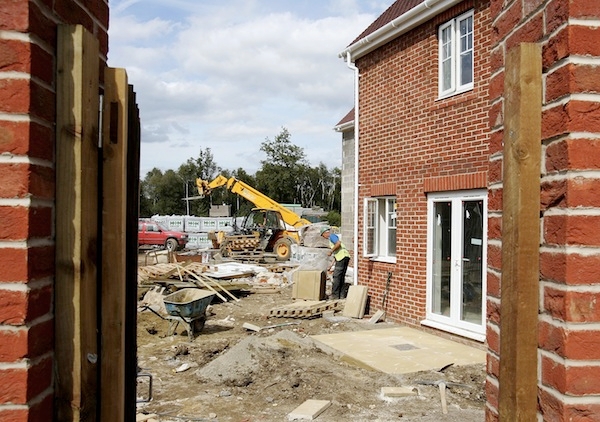An Englishman’s home is his castle. And today, record numbers of people are living that adage thanks to Help to Buy; a scheme that is reviving house-building after decades of inaction.
Statistics released today show more than 27,000 homes have been bought through Help to Buy. This is great news. For too long, hardworking people in this country have been priced out of the housing market: for the simple reason that demand was outstripping supply and because prospective buyers who could afford a mortgage were not able to stump up the huge deposits banks were demanding.
Politicians on all sides recognise this problem; but it is this Conservative-led government which is taking action. With the average house price in UK now at £252,000, we recognise that a £50k deposit for someone on an average salary of £26,500 is a tall order. An injection of capital is needed at both ends, to let people buy homes and boost the housing supply.
Help to Buy, which supports people buying a home with a small deposit (the type that became very hard to access in the wake of Labour’s financial crash) offers that two-pronged solution. The Equity Loan, introduced in April 2013, gives buyers of new build properties a government loan of 20 per cent of the sale price; while the mortgage guarantee, launched five months ago, allows buyers to access mortgages with a loan worth up to 95 per cent of the sale price, by giving high-street lenders a government guarantee against losses on those mortgages.
Of course, we remain vigilant about risks to the housing market – we don’t want to repeat Labour’s mistakes. Before the financial crisis, under Labour, people were being allowed to borrow 120 per cent of the value of the house they were purchasing – with minimal checks. That is why this government created the Financial Policy Committee at the Bank of England, which has the tools to intervene in the housing market to ensure economic stability.
This is not just about helping people; this is about helping business. Help to Buy is getting Britain building again through responsible lending. Every loan under the Equity Loan scheme means a new build home is built, and of the 1,200 builders registered with the scheme, over 90 per cent are small or medium enterprises. Stewart Baseley, the executive chairman of the Home Builders Federation, says: “Help to Buy has reinvigorated the home building industry, contributed to a sharp increase in new housing starts and allowed thousands of first-time buyers onto the housing ladder.”
It’s no coincidence that house-building is now at its highest level since 2007; that more jobs have been created as a result; and that hardworking families right across the country are fulfilling their dreams of buying a home, which allows them to plan for the future with security and certainty. The main beneficiaries of Help to Buy are those who are starting out in life. The average sales price under the Equity Loan scheme stands at £204,805 and for the Mortgage Guarantee is £151,957. And eight out of ten sales are to first-time buyers.
Since Help to Buy was launched in April 2013, private house-building has risen by 34 per cent. Research conducted by Morgan Stanley suggests about 30 per cent of all new builds in England are being funded by Help to Buy – and that by 2016 it could be responsible for up to a 55 per cent increase in English housing statistics compared with 2012 levels. In the long term, we need to accelerate the number of homes we build to make sure that even more families can afford to get on the housing ladder.
But listen to the cries of indignation from Labour today. When they will repeat (without a hint of irony) that rising demand for housing must be matched by rising supply – and yet again we will hear Labour’s pledge to build 200,000 homes annually by 2020.
Oh, how Labour loves to bash us on housing! But it’s pure political posturing. They didn’t get it right in 13 years, despite 9 different housing ministers promising the world. They set an annual target of 200,000 homes which Gordon Brown (advised by Ed Miliband at the time) accelerated to 240,000. The reality? Under Labour, house-building fell to levels not seen since the 1920s, meaning people who were doing the right thing couldn’t afford the deposit they needed to buy their own home. Even today in Labour-run Wales, red tape adds up to £13,000 to the cost of building a home, which has contributed to a 12 per cent fall in new home registrations last year.
Overall, housing starts are now 113 per cent higher than in 2009, the trough of Labour’s housing crash. In addition, the National House Building Council reported housing registrations rose by 30 per cent in England in 2013, and in London by 60 per cent to the highest annual total since their records began 26 years ago.
Help to Buy is just one of several interventions we’ve put in place to support the housing market. Others include the delivery of 170,000 affordable homes since 2010; building twice as many council houses in four years Labour did in 13; and investing more than half a billion pounds to support SME builders.
The recovery we are seeing in the English housing market is part of this government’s wider economic recovery. It’s going from strength to strength and its foundations are solid. Our Labour opponents, who have no long-term economic plan and who presided over a disastrous housing crash, should be careful not to throw stones. We’re building British homes in bricks and mortar.
Kris Hopkins is Housing Minister and Conservative MP for Keighley and Ilkley






Comments